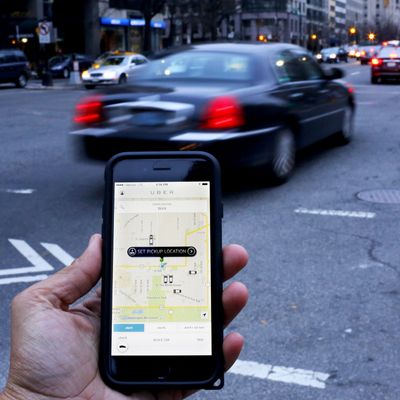
Yesterday, the New York Times ran a really fascinating article by Noam Scheiber about the many ways Uber tries to manipulate its drivers through behavioral science. The company is trying to solve basic problems baked into its business model: From Uber’s point of view, it’s great to have tons of drivers on the road, because that means customers don’t have to wait as long to get picked up. But from drivers’ points of view, having fewer fellow drivers on the road is best, because it means less time idling and earning no money (since drivers get paid only per ride, not on an hourly basis).
So Uber has introduced all sorts of nudge-y tricks to try to keep drivers driving. Some involve gamification — drivers can earn certain (meaningless) badges if they meet certain performance benchmarks — while others involve subtler forms of engineering, like building menus and interfaces in a way where certain options are easier to click. Drivers, Scheiber’s reporting reveals, often feel they’re being nudged into working more than they want to for less than they feel they should be earning.
Uber’s practices come off as fairly creepy — as Scheiber writes early on, Uber “is engaged in an extraordinary behind-the-scenes experiment in behavioral science to manipulate them in the service of its corporate growth.” And later there’s an alarming quote from Ryan Calo, a law professor at the University of Washington, which also invokes that M-word: “We’re talking about this kind of manipulation that literally affects people’s income,” he said, adding that Uber’s geeks are “using what they know about drivers, their control over the interface and the terms of transaction to channel the behavior of the driver in the direction they want it to go.”
But as Daniel Engber and Zeynep Tufekci pointed out in some noteworthy tweet-responses to the article, people seem to be missing a bit of the broader story here: It has always been the case that companies try to optimize their products or labor practices in this sort of way, and Uber is simply responding to the bigger, broader landscape of the so-called “gig economy,” which allows it to (some might argue) exploit labor via nudging in the first place.
It could, of course, simultaneously be the case that Uber isn’t a particularly worker-friendly company (to say the least), and also that people are focusing their complaints too narrowly on the sexy, novel-seeming behavioral stuff. As Engber rightly points out, the problem of motivating workers is by no means new — what’s new are the data-heavy techniques employed to achieve that end.
At the end of the day, companies are going to seek to maximize their profit. Uber exists within a broader American framework in which workers are increasingly alone, batted around by epochal forces, simply trying to get by — that’s the vaunted new gig economy. Those forces exist regardless of whether and to what extent Uber gamifies its driver interface and feedback. Which isn’t to let Uber off the hook — again, it would be great if companies acted in more labor-friendly ways — but rather to point out that the problems highlighted by Scheiber’s article might run a bit deeper than people think. They might have more to do with core questions of American policy and law than with the latest behavioral research.




